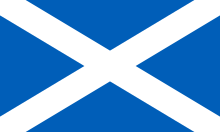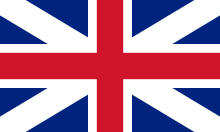Act of Union 1707
The Act of Union 1707 ( German Unification Act ) created the legal basis for the unification of the Kingdom of England and the Kingdom of Scotland . This averted the threatened bankruptcy of Scotland.
The law was passed in quick succession by the English Parliament and the Scottish Parliament and entered into force on May 1, 1707 (according to the Julian calendar applicable in England and Scotland ). The Treaty of Union was implemented with the law . It provided for the creation of the Kingdom of Great Britain and the replacement of the English and Scottish Parliaments by the British Parliament .
background
As early as 1606, 1667 and 1689 there had been attempts to unite the two countries linked by personal union politically. But now both parliaments were behind the treaty, albeit for very different reasons. England wanted to enforce the Protestant succession regulation under the Act of Settlement of 1701 in both countries in order not to have to rely on the Act of Security passed by Scotland in 1704 . The English feared that an independent Scotland with its own king, even if he were Protestant , might revive the Auld Alliance with France and oppose England. With the union, the opening of a second front in the War of the Spanish Succession was prevented.
The Scottish state, which was de facto bankrupt after the failure of William Paterson's Darién project , was given the opportunity with the union to shift its debts, albeit with the surrender of full sovereignty. At the same time, the threatened economic sanctions in the Alien Act passed by England in 1705 could be averted. In addition, the Company of Scotland's creditors were compensated and Scotland was given unrestricted access to the markets and colonies of England.
implementation
The Union Treaty contained 25 articles, 15 of which were economic in nature. In Scotland, Parliament voted on each article individually and some clauses were discussed in more detail in specialized commissions. Article 1 of the agreement stipulated the merger of the two countries into a union and was adopted on November 4, 1706 with 116 votes to 83. To reduce opposition from the Church of Scotland , the Scottish Parliament passed an additional law giving Presbyterians priority on religious matters. The treaty as a whole was approved on February 16, 1707 by 110 votes to 69.
Many Scottish MPs acted out of self-interest, as they had lost a lot of money with the Darién project and could expect compensation under the Union Treaty. In addition, numerous Scottish MPs were bribed for a total of £ 20,000. Of that, £ 12,325 went to the Earl of Glasgow, Queen Anne's representative in the Scottish Parliament. The treaty met with a majority of rejection in Scotland, especially among the common people. The Scottish Parliament received numerous petitions directed against the Union. There were protests in Edinburgh and many other Scottish cities. When the country threatened to come to the brink of civil war, parliament reacted by proclaiming martial law.
The Act of Union established the dissolution of the Scottish Parliament. Instead, Scotland sent 16 peers from the Peerage of Scotland as representative peers to the British House of Lords and 45 MPs to the British House of Commons . The contract guaranteed the independence of the Church of Scotland and the preservation of the Scottish legal system with the Court of Session as the higher civil court. In addition, a customs union and a monetary union came into force, and weights and measures, as well as administrative and taxation systems, were aligned. The Union Jack , the new flag, also comes from agreements in the Act of Union.
See also
literature
- Daniel Defoe : A tour thro 'the whole island of Great Britain , 1724-27 .
- Daniel Defoe: The Letters of Daniel Defoe. GH Healey, Oxford 1955.
- Andrew Fletcher : An Account of a Conversation .
- Arthur Herman: How the Scots Invented the Modern World . Three Rivers Press, 2001, ISBN 0-609-80999-7 .
Web links
- History - The Treaty of Union (English)
- Treaty of Union and the Darien Experiment (English)
- Union with Scotland Act 1706 (English)
- Come together: Union of Scotland and England
- Law on Union with Scotland
Individual evidence
- ↑ PJW Riley, The English Historical Review, Volume 84, No. 332 (July 1969), pp. 523-524



